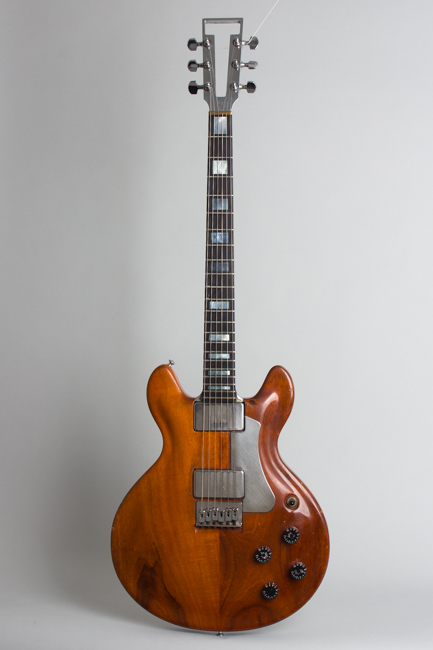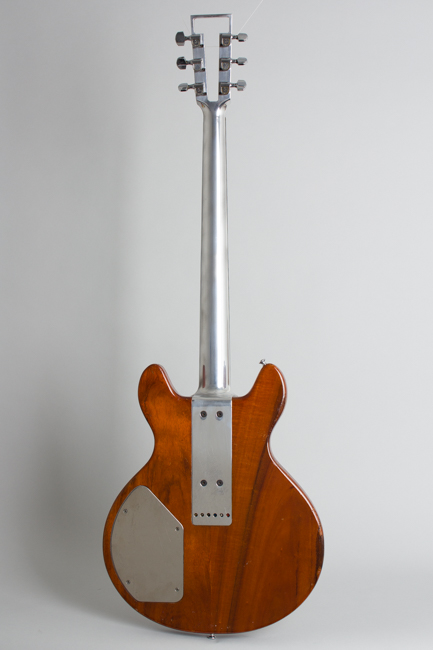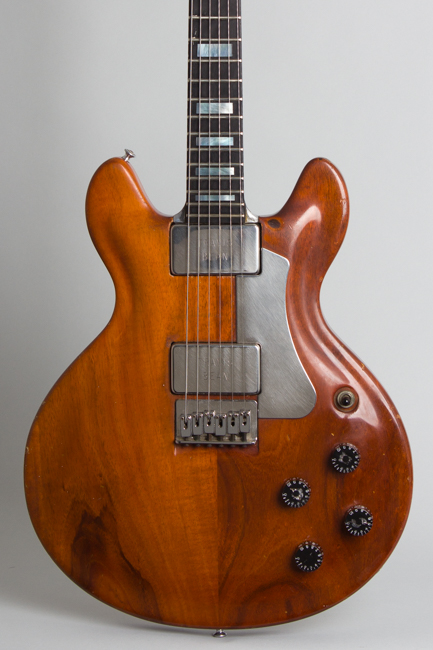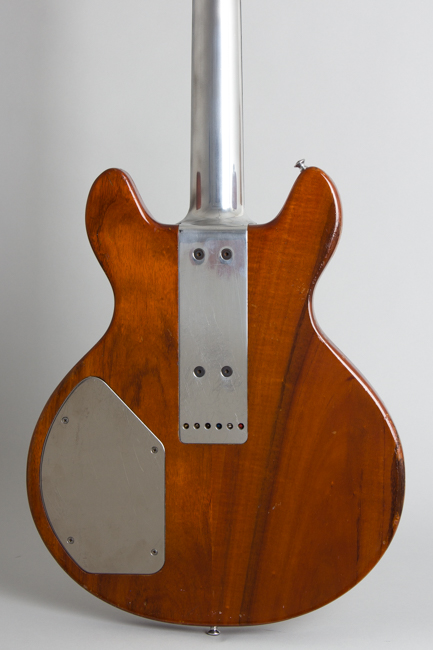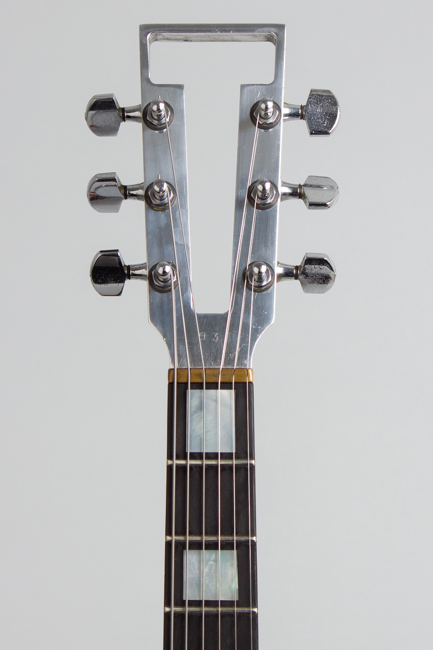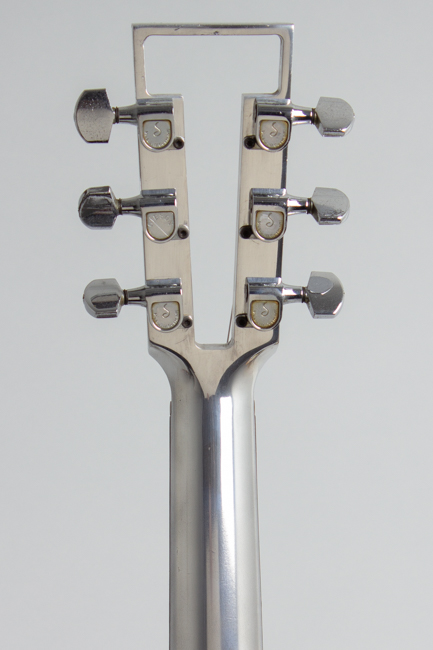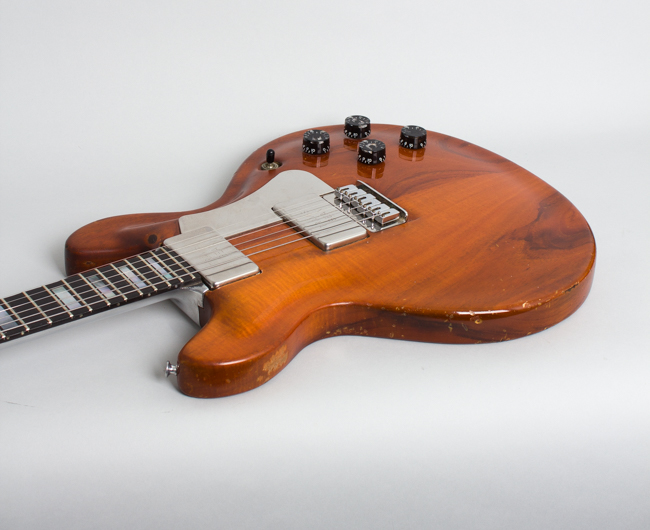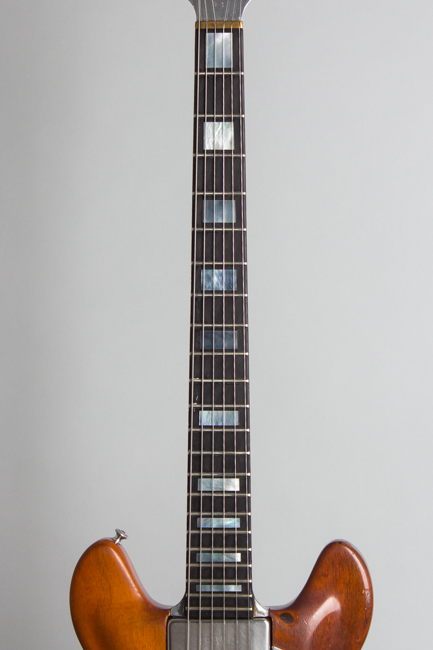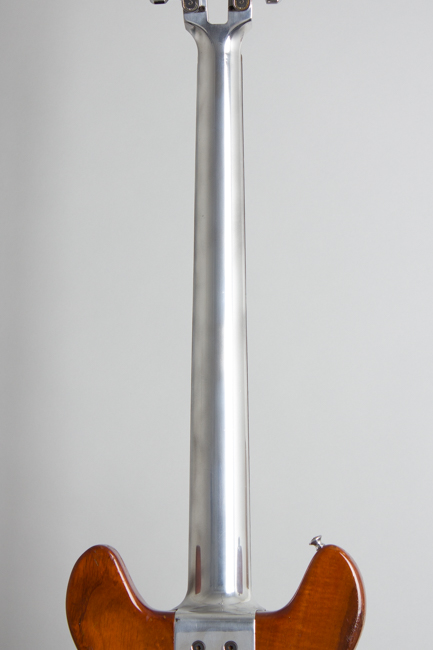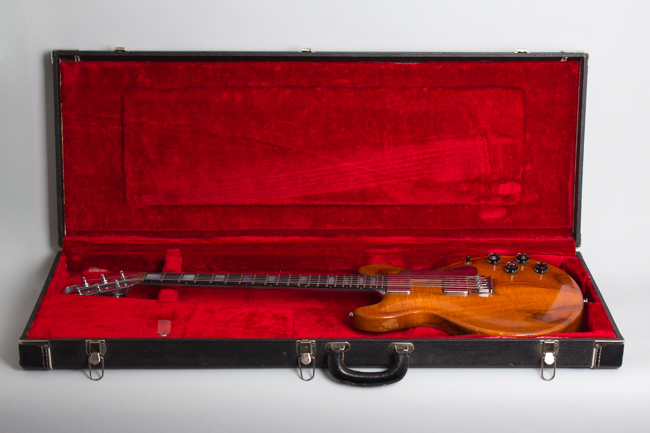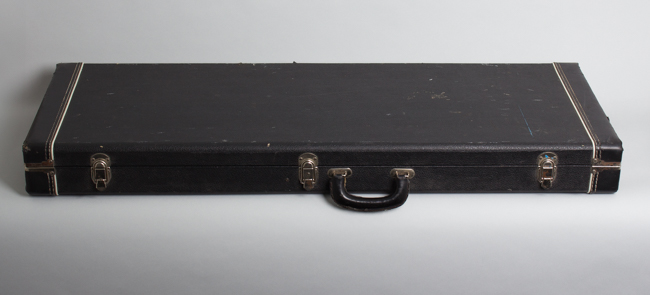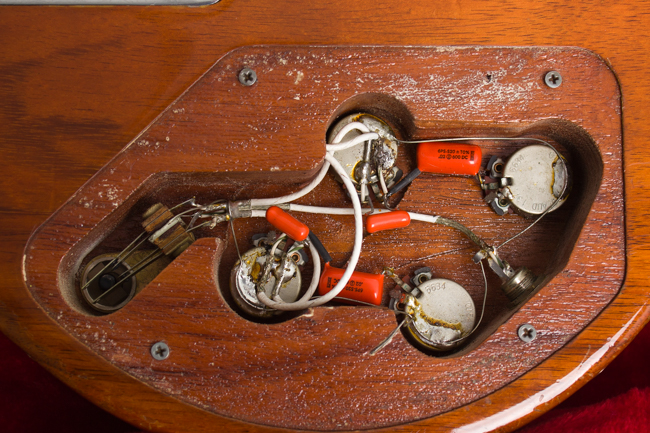Travis Bean TB-1000A Solid Body Electric Guitar (1975)
Travis Bean TB-1000A Model Solid Body Electric Guitar (1975), made in Sun Valley, CA, serial # 93, natural lacquer finish, aluminum neck and centerpiece, koa wood body,rosewood fingetboard, period black tolex hard shell case.
This mid-1970's classic is a VERY early, first-run example of the Travis Bean TB1000A "Artist", the high-end model in the company's innovative but short-lived guitar line. This played-in but original example mates their patented raison d'etre aluminum neck/centerpiece to a carved solid Hawaiian koa wood body and ebony fingerboard with pearl block inlay. The company also offered the "Standard" TB1000S, similar but less deluxe, the budget TB-500 and the eccentrically shaped "Wedge" models. Of all of these the TB-1000A is the "classic" Bean, the most widely recognized and fondly remembered model.
Former motocross racer and lifelong tinkerer Clifford Travis Bean had two partners initially; guitar tech Marc McElwee and one Gary Kramer, who split off to found his own (for a time) hugely successful guitar operation. Ads claimed their aluminum-necked designs were "the first new development in the electric guitar since the 1930s" although whether they were considering the early cast aluminum Rickenbacker steels is a moot point! The catalog continued "The...lightweight neck and receiver system forms a rigid link between the tuning machines and the bridge. When the strings are attached, a complete vibration connection is achieved. It is this patented chassis that makes the Travis Bean guitar what it is: an instrument that has become the most dramatic breakthrough in electric guitar technology in 50 years."
Bean's patented concept was a through-neck/central body core milled from T6061 aircraft aluminum, extending from headstock to the through-the-body strung six-saddle bridge. Narrow chambers running its length improved resonance and reduced weight, if only slightly. This metal centerpiece is mounted into a Hawaiian koa wood body finished in natural lacquer. All the higher end models mounted the company's own Alnico magnet humbucking pickups with "Travis Bean" engraved on their covers - the only branding on the instrument besides the subtle "T" cut out of the headstock! These in-house pickups have a stellar reputation on their own, but were never used on any other instruments.
This is a very early Artist, carrying serial number #93 stamped into the headstock which would indicate manufacture in the first production year 1975. The neck is quite a bit slimmer at the nut than later examples, and the elegantly carved body larger and deeper but subtly slimmer in the horns. The Koa body has a beautiful grain pattern with some bold asymmetrical mineral streaking on the face. The original pots are dated to the 34th week 1966; It's likely the start-up company bought some job-lot supplies in the beginning!
The Artist model retailed originally for $1,395, making it one of the most expensive solidbody guitars available in 1975. While not a huge commercial success Beans were featured by some major artists. Keith Richards, Ron Wood, and Bill Wyman all played them with the Rolling Stones in the mid '70s. Jerry Garcia played both a TB 1000 and a TB 500 for a time, so many deadheads revere them to this day. The guitars garnered a reputation for very high quality but many players felt the bare aluminum neck had a cold feel.
More recently, Travis Beans have been gainfully employed by a number of noise-rock players along with many denizens of myriad heavy sub-genres like doom and stoner metal. The Bean sound is powerful and articulate at lover volumes, but winds up magnificently to a shuddering crunch when pushed in these heavy contexts. It has a lot of gain which makes it ideal for plugging in using a passive direct box straight into mic preamp input modules. Travis Bean knew he had something great in the mid-1970s; while his vision did not lead to major success at the time he would no doubt be well satisfied by the lasting appeal to players and highly collectible status his creations have earned nearly 50 years on.
Overall length is 39 3/8 in. (100 cm.), 14 1/8 in. (35.9 cm.) wide at lower bout, and 1 3/8 in. (3.5 cm.) in depth, measured at side of rim. Scale length is 24 1/2 in. (622 mm.). Width of nut is 1 1/2 in. (38 mm.)., 10 lbs.
This Bean shows some moderately heavy play wear overall but remains all original and in excellent playing condition. The body finish shows numerous nicks, scrapes and dings most heavily on the edges and the back with some finish rubbed down to the wood on the upper rim. The fittings and electronics remain original and relatively clean for a played-in 50 year old instrument. The aluminum pickguard remains cleaner than many but lower part of the neck extension (in the center of the body) shows some heavy belt buckle scuffing. The back of the neck itself has only some very light marks and still shines in its natural aluminum glory.
The pots and wiring appear original although a couple of solder joints may have been redone The ebony fret board and original frets show only fairly light wear; the large, wide frets appear to have been recrowned in the past. This is a great playing and powerful sounding first-generation Travis Bean, increasingly hard to find in the 21st century. It resides in a period rectangular black Tolex hard case that may be original, carrying markings from a recent stay at the Wilco Loft. Very Good + Condition.
This mid-1970's classic is a VERY early, first-run example of the Travis Bean TB1000A "Artist", the high-end model in the company's innovative but short-lived guitar line. This played-in but original example mates their patented raison d'etre aluminum neck/centerpiece to a carved solid Hawaiian koa wood body and ebony fingerboard with pearl block inlay. The company also offered the "Standard" TB1000S, similar but less deluxe, the budget TB-500 and the eccentrically shaped "Wedge" models. Of all of these the TB-1000A is the "classic" Bean, the most widely recognized and fondly remembered model.
Former motocross racer and lifelong tinkerer Clifford Travis Bean had two partners initially; guitar tech Marc McElwee and one Gary Kramer, who split off to found his own (for a time) hugely successful guitar operation. Ads claimed their aluminum-necked designs were "the first new development in the electric guitar since the 1930s" although whether they were considering the early cast aluminum Rickenbacker steels is a moot point! The catalog continued "The...lightweight neck and receiver system forms a rigid link between the tuning machines and the bridge. When the strings are attached, a complete vibration connection is achieved. It is this patented chassis that makes the Travis Bean guitar what it is: an instrument that has become the most dramatic breakthrough in electric guitar technology in 50 years."
Bean's patented concept was a through-neck/central body core milled from T6061 aircraft aluminum, extending from headstock to the through-the-body strung six-saddle bridge. Narrow chambers running its length improved resonance and reduced weight, if only slightly. This metal centerpiece is mounted into a Hawaiian koa wood body finished in natural lacquer. All the higher end models mounted the company's own Alnico magnet humbucking pickups with "Travis Bean" engraved on their covers - the only branding on the instrument besides the subtle "T" cut out of the headstock! These in-house pickups have a stellar reputation on their own, but were never used on any other instruments.
This is a very early Artist, carrying serial number #93 stamped into the headstock which would indicate manufacture in the first production year 1975. The neck is quite a bit slimmer at the nut than later examples, and the elegantly carved body larger and deeper but subtly slimmer in the horns. The Koa body has a beautiful grain pattern with some bold asymmetrical mineral streaking on the face. The original pots are dated to the 34th week 1966; It's likely the start-up company bought some job-lot supplies in the beginning!
The Artist model retailed originally for $1,395, making it one of the most expensive solidbody guitars available in 1975. While not a huge commercial success Beans were featured by some major artists. Keith Richards, Ron Wood, and Bill Wyman all played them with the Rolling Stones in the mid '70s. Jerry Garcia played both a TB 1000 and a TB 500 for a time, so many deadheads revere them to this day. The guitars garnered a reputation for very high quality but many players felt the bare aluminum neck had a cold feel.
More recently, Travis Beans have been gainfully employed by a number of noise-rock players along with many denizens of myriad heavy sub-genres like doom and stoner metal. The Bean sound is powerful and articulate at lover volumes, but winds up magnificently to a shuddering crunch when pushed in these heavy contexts. It has a lot of gain which makes it ideal for plugging in using a passive direct box straight into mic preamp input modules. Travis Bean knew he had something great in the mid-1970s; while his vision did not lead to major success at the time he would no doubt be well satisfied by the lasting appeal to players and highly collectible status his creations have earned nearly 50 years on.
Overall length is 39 3/8 in. (100 cm.), 14 1/8 in. (35.9 cm.) wide at lower bout, and 1 3/8 in. (3.5 cm.) in depth, measured at side of rim. Scale length is 24 1/2 in. (622 mm.). Width of nut is 1 1/2 in. (38 mm.)., 10 lbs.
This Bean shows some moderately heavy play wear overall but remains all original and in excellent playing condition. The body finish shows numerous nicks, scrapes and dings most heavily on the edges and the back with some finish rubbed down to the wood on the upper rim. The fittings and electronics remain original and relatively clean for a played-in 50 year old instrument. The aluminum pickguard remains cleaner than many but lower part of the neck extension (in the center of the body) shows some heavy belt buckle scuffing. The back of the neck itself has only some very light marks and still shines in its natural aluminum glory.
The pots and wiring appear original although a couple of solder joints may have been redone The ebony fret board and original frets show only fairly light wear; the large, wide frets appear to have been recrowned in the past. This is a great playing and powerful sounding first-generation Travis Bean, increasingly hard to find in the 21st century. It resides in a period rectangular black Tolex hard case that may be original, carrying markings from a recent stay at the Wilco Loft. Very Good + Condition.
